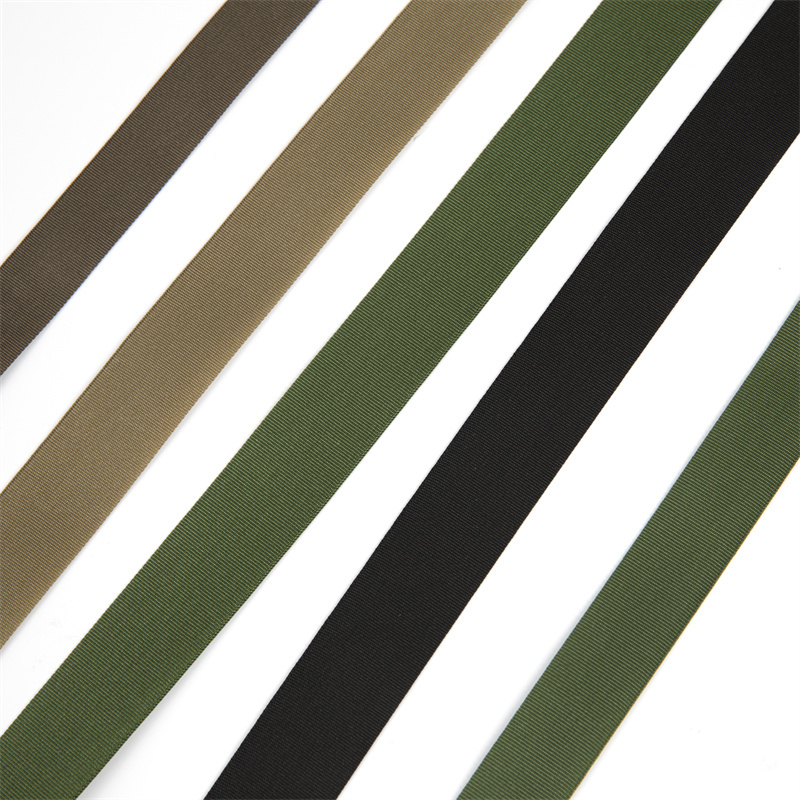Exploring the Manufacturing Standards of MIL SPEC Webbing: A Comprehensive Guide
Jul 20,2025

Exploring the Manufacturing Standards of MIL SPEC Webbing
In the realm of textiles, the significance of manufacturing standards cannot be overstated, especially when it comes to MIL SPEC webbing. Utilized extensively across military and industrial applications, MIL SPEC webbing adheres to stringent standards that ensure durability, reliability, and safety. This article aims to provide a thorough understanding of the manufacturing standards associated with MIL SPEC webbing, its various applications, and why these standards are indispensable in today’s market.
Understanding MIL SPEC Webbing
MIL SPEC webbing refers to webbing materials that conform to military specifications, ensuring they meet rigorous quality and performance criteria. These specifications are crucial for applications where safety and performance are paramount, such as in military gear, climbing equipment, and safety harnesses. The following sections will delve into the various facets of these standards, including material selection, design considerations, and testing protocols.
The Importance of Manufacturing Standards in Webbing
Manufacturing standards play a vital role in maintaining quality and consistency in webbing products. They ensure that all materials used in the production of MIL SPEC webbing are of the highest quality, thus guaranteeing performance under extreme conditions. Adhering to these standards helps manufacturers produce reliable products that can withstand harsh environments, making them essential for military and industrial applications.
Key Standards Governing MIL SPEC Webbing
Various standards govern the production and testing of MIL SPEC webbing. These include:
- MIL-W-4088: This specification outlines the requirements for nylon webbing used in military applications.
- MIL-W-5040: This standard covers the requirements for woven polyester webbing.
- A-A-55301: This specification details the requirements for webbing used in parachute applications.
Each of these standards offers detailed guidelines on material properties, construction methods, and testing protocols to ensure the reliability and safety of the webbing.
The Manufacturing Process of MIL SPEC Webbing
The manufacturing process for MIL SPEC webbing involves several critical steps, each designed to meet specific standards. Understanding this process is essential for both manufacturers and end-users.
Material Selection for MIL SPEC Webbing
The choice of materials is foundational to the production of high-quality MIL SPEC webbing. Common materials used include:
- Nylon: Known for its strength and elasticity, nylon is a popular choice for webbing used in military and tactical applications.
- Polyester: This material is favored for its resistance to UV light and moisture, making it suitable for outdoor use.
- Polypropylene: Lightweight and resistant to chemicals, polypropylene is often used in applications where weight is a critical factor.
Selecting the right material depends on the intended application, as each material has unique properties that affect performance.
Design Considerations in Webbing Production
Designing MIL SPEC webbing involves meticulous attention to detail, ensuring that the final product meets both functional and safety requirements. Important design considerations include:
- Width and Thickness: Different applications require varying widths and thicknesses to provide adequate support and load-bearing capabilities.
- Weave Patterns: Different weave patterns can enhance the strength and flexibility of the webbing, affecting its performance in specific applications.
- Color and Finish: Color coding can be used for identification and function, while finishes can enhance durability and resistance to environmental factors.
Testing and Quality Assurance of MIL SPEC Webbing
To ensure that MIL SPEC webbing meets the required standards, rigorous testing and quality assurance measures are implemented throughout the manufacturing process.
Physical Property Testing
Various physical property tests are conducted to assess the performance of MIL SPEC webbing. These tests typically include:
- Tensile Strength Tests: Measuring the maximum load the webbing can bear before breaking.
- Elongation Tests: Assessing how much the webbing stretches under load, which is crucial for applications requiring flexibility.
- Environmental Resistance Tests: Evaluating how well the webbing performs under exposure to UV light, moisture, and extreme temperatures.
Compliance and Certification
Compliance with military specifications is vital for manufacturers of MIL SPEC webbing. This involves obtaining certification that the products meet all outlined standards. Third-party testing facilities often conduct these evaluations, providing an unbiased assessment of product quality.
Applications of MIL SPEC Webbing
MIL SPEC webbing is used in a wide variety of applications, highlighting its versatility and reliability. Some notable uses include:
Military Applications
In military contexts, MIL SPEC webbing is utilized in gear such as backpacks, harnesses, and tactical belts. The durability and strength of this webbing make it ideal for military personnel operating in demanding environments.
Industrial Applications
Industries such as construction and manufacturing use MIL SPEC webbing for safety harnesses, lifting equipment, and cargo securing systems. The high-quality standards ensure worker safety and equipment reliability.
Outdoor and Recreational Use
Outdoor enthusiasts rely on MIL SPEC webbing for climbing gear, camping equipment, and survival kits. The strength and durability of this webbing provide peace of mind in extreme environments.
Advantages of Using MIL SPEC Webbing
Opting for MIL SPEC webbing offers numerous benefits, making it a preferred choice across various sectors.
- Durability: The robust construction of MIL SPEC webbing ensures longevity, even in harsh conditions.
- Reliability: Meeting military standards guarantees that the webbing will perform as needed in critical situations.
- Versatility: MIL SPEC webbing can be employed in a multitude of applications, from military gear to industrial uses.
Challenges in Manufacturing MIL SPEC Webbing
While the production of MIL SPEC webbing has its advantages, it also presents several challenges that manufacturers must navigate.
Adhering to Rigorous Standards
The stringent requirements set forth by military specifications can be difficult to meet. Manufacturers must ensure they have the right processes, materials, and testing protocols in place to achieve compliance consistently.
Cost Implications
High-quality materials and extensive testing can lead to increased production costs. Balancing quality with affordability is a challenge that manufacturers face, particularly in competitive markets.
Keeping Up with Technological Advancements
As technology evolves, so do manufacturing processes. Staying abreast of new technologies and integrating these into production can pose a challenge, but it is essential for maintaining competitiveness and quality in the market.
Future Trends in MIL SPEC Webbing Manufacturing
The future of MIL SPEC webbing manufacturing is poised for evolution, driven by advancements in materials and technology.
Innovative Materials
Research into new materials that offer enhanced performance and sustainability is becoming increasingly important. Bio-based and recycled materials may play a significant role in the future of webbing production.
Smart Textiles
Integrating technology into webbing, such as sensors for monitoring stress and load, could revolutionize its application and safety. Smart textiles represent an exciting frontier in the manufacturing of military and industrial gear.
Frequently Asked Questions (FAQs)
1. What does MIL SPEC stand for?
MIL SPEC stands for Military Specifications, which are standards set by the U.S. Department of Defense that outline the requirements for materials, products, and processes used in military applications.
2. What materials are commonly used in MIL SPEC webbing?
The most common materials used in MIL SPEC webbing include nylon, polyester, and polypropylene, each chosen for their unique properties and suitability for specific applications.
3. How is MIL SPEC webbing tested for quality?
Quality testing involves various physical tests, including tensile strength, elongation, and environmental resistance tests, to ensure the webbing meets the required standards.
4. In what industries is MIL SPEC webbing used?
MIL SPEC webbing is extensively used in military applications, industrial safety equipment, and outdoor recreational gear, due to its durability and reliability.
5. What are the advantages of using MIL SPEC webbing over regular webbing?
MIL SPEC webbing offers superior durability, reliability, and compliance with rigorous safety standards, making it ideal for critical applications where performance matters.
Conclusion
Understanding the manufacturing standards of MIL SPEC webbing is essential for anyone involved in its production or use. From material selection and design considerations to rigorous testing protocols, every aspect is crucial to ensuring that the webbing meets the demands of military and industrial applications. As technology progresses and new materials emerge, the future of MIL SPEC webbing manufacturing will continue to evolve, providing reliable and high-performance solutions for various industries. By adhering to these standards, manufacturers can guarantee the strength, durability, and safety of their products, ultimately benefiting users across the spectrum.
PREVIOUS:
Related Posts
Contact Us
E-mail:
Phone/WeChat:
Factory Address:
No. 601 ShiXing Road, Jimei District, Xiamen, 361024, China







